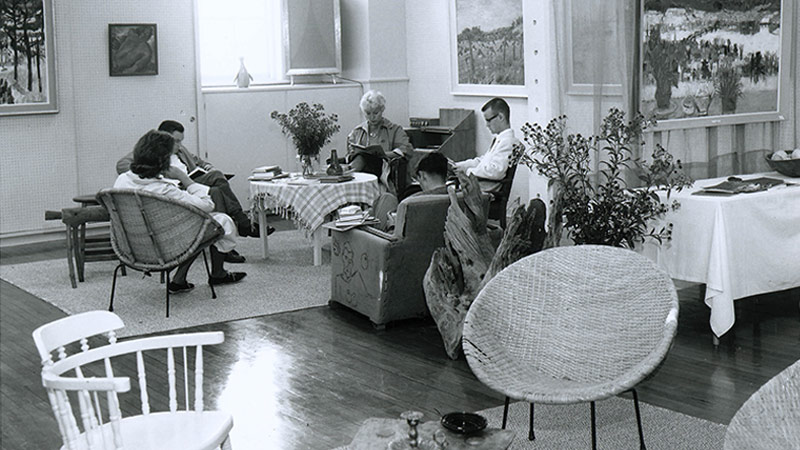Timeless tribute: Honouring a century of legacy at Memorial Hall
Author: Angie Deveau
Posted on Aug 28, 2023
Category: UNB Fredericton

Students lounging at the UNB Art Centre in 1961.
On Sept. 8, the UNB Art Centre will commemorate Memorial Hall’s 100th Anniversary. To kick off this celebration, this article shares memories from community members spanning the past century.
Named in memory of University of New Brunswick (UNB) graduates and students who fought and died during the First World War, Memorial Hall opened in 1924.
Since its opening, the hall has served as a convocation space and provided teaching and learning spaces for a variety of subjects, including science, physics, engineering and physical education. Two radio stations, CFNB and CHSR, also ran out of Memorial Hall. It now houses the UNB Art Centre and the Centre for Musical Arts.
Stephen Patterson, a historian and professor emeritus at UNB, has had a long connection to Memorial Hall. In 1955, he enrolled in UNB’s bachelor of arts program. He vividly recalls that time.
“I took chemistry from Dr. Toole in Memorial Hall at 8:30 a.m. on Mondays, Wednesdays and Fridays,” said Patterson. “He taught in the main auditorium using slides. The room was dimmed, and someone on the balcony ran an old-fashioned slide projector and put his notes and formulas on the screen.”
After venturing into music and drama in his second year of his BA, Patterson began creating and performing musical comedies during UNB’s winter carnival.
“I did two musicals in Mem Hall, and everyone who bought a winter carnival ticket got a ticket to one of our performances,” he said. “The musicals were spoofs of Fredericton and New Brunswick, and they attracted a lot of attention in the community.”
After graduating and furthering his studies outside the province, Patterson became a faculty member and the chair of the creative arts committee. Through this role, he convinced then-UNB president James Downey to purchase a grand piano for Memorial Hall. They bought one once played in a performance by Oscar Peterson.
John Ball, a faculty member who teaches English in UNB’s faculty of arts, also worked at Memorial Hall throughout his career. He was hired to teach post-colonial literature but has taught drama production courses, as a back-up to director of drama Len Falkenstein, as well.
He said many students attach strongly to the space.
“Students love Mem Hall, particularly after they've been in the program for a while,” said Ball. “They feel the history almost coming off the walls or embedded in the wood and the stained-glass windows.”
Ball recounted the challenges of producing plays in Memorial Hall, like the time they sprinkled water on the stage from the attic when the play called for a flood. He also mentioned the building's quirky features (such as backstage spiral staircases) and its reputation for having a ghost. He said the hall's beauty, historical significance and up-to-date equipment have made it a cherished space for theatre, performances and learning.
As the director of the Centre for Musical Arts, Richard Hornsby started working at Memorial Hall 31 years ago. He said Memorial Hall has been home to resident musicians who performed frequently and brought to the Memorial Hall stage top talent from around the country from the 1960s to the 1990s. It was one of the things that attracted him to UNB.
“There are two or three buildings on the campus that people frequent that give you a sense of the institution being here for a long time,” he said. “This building exemplifies that.”
He said its auditorium is suitable for different kinds of music, most notably chamber music. “You’re not going to put a full orchestra on that stage,” said Hornsby. “It's too small, but for the things that I specialize in, it's gorgeous. It's also uniquely located. If we want to record in that building, we're not near a major highway, and we're far from a major thoroughfare.”
Hornsby also described how the New Brunswick Summer Music Festival holds many major concerts in Memorial Hall. “Over the last 30 years, we’ve had several artists, mostly Canadian,” he said. “Many of them have gone on to have successful careers.”
Marie Maltais, director of the UNB Art Centre, also notes the centre’s extensive history with Memorial Hall. The UNB Art Centre moved to Memorial Hall in the 1960s. Under Bruno Bobak and then Marjory Donaldson, the centre presented exhibits featuring Maritime artists as well as classes in drawing and painting.
Today the UNB Art Centre continues to present exhibits that promote dialogue and discussion and continues to provide courses in painting as one of the many courses offered through Leisure Learning non-credit courses and Design Works summer camps for kids.
Maltais said the UNB Permanent Collection, which began with only a few paintings now numbers 2,500 artworks and is displayed across the campus. She also said the UNB Art Centre reflects contemporary values in its programming. Since 2011, it has developed exhibits bringing awareness to social and environmental issues, particularly water stewardship through its participation in World Water Day.
She also highlighted one of the centre’s most notable projects, Rediscovering the Roots of Black New Brunswickers.
“For the last five years we have celebrated Black History Month through this project,” said Maltais. “It brings to light Black New Brunswickers who have made a significant contribution to shaping contemporary New Brunswick in their fight for freedom and equality.”
As Memorial Hall reaches its 100th year, its legacy continues to inspire and guide generations of students, faculty and artists.
To participate in the centennial celebration, find out more.
